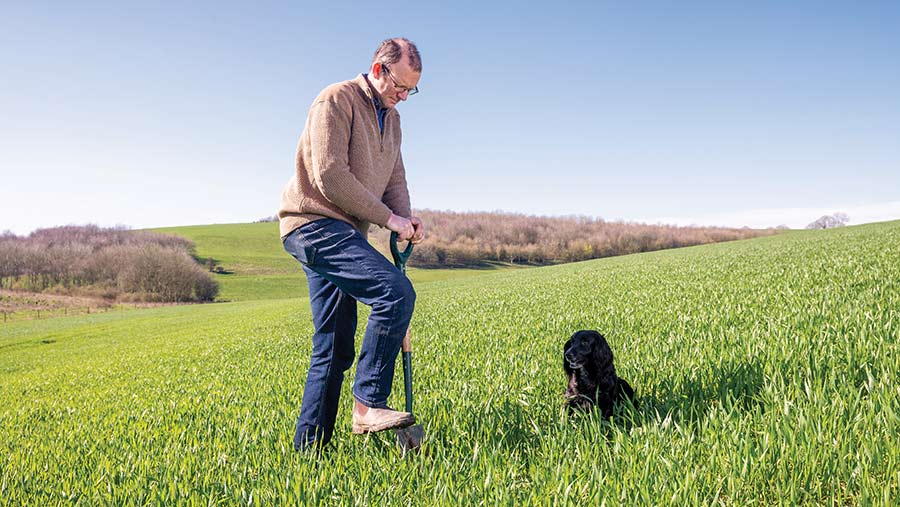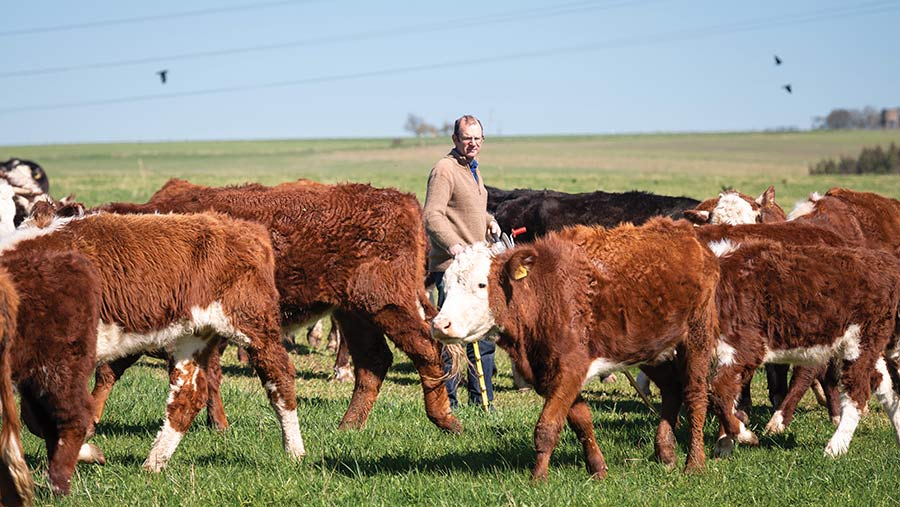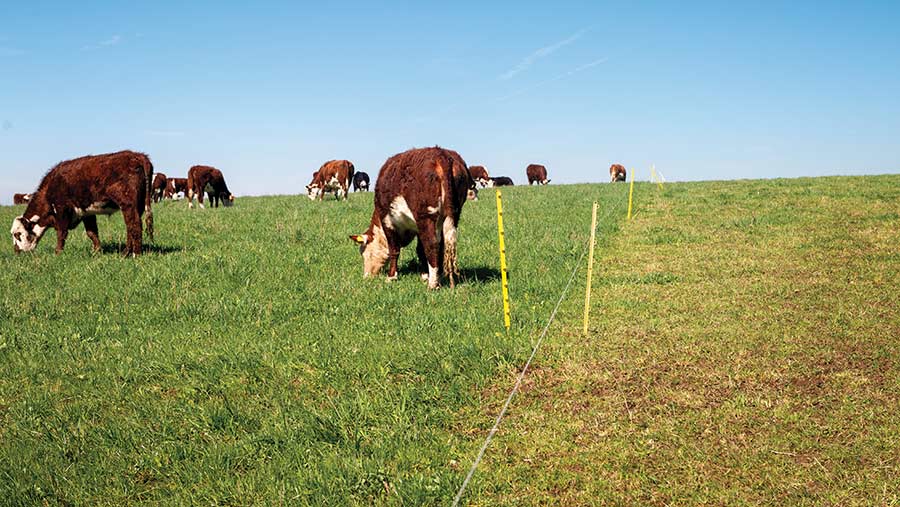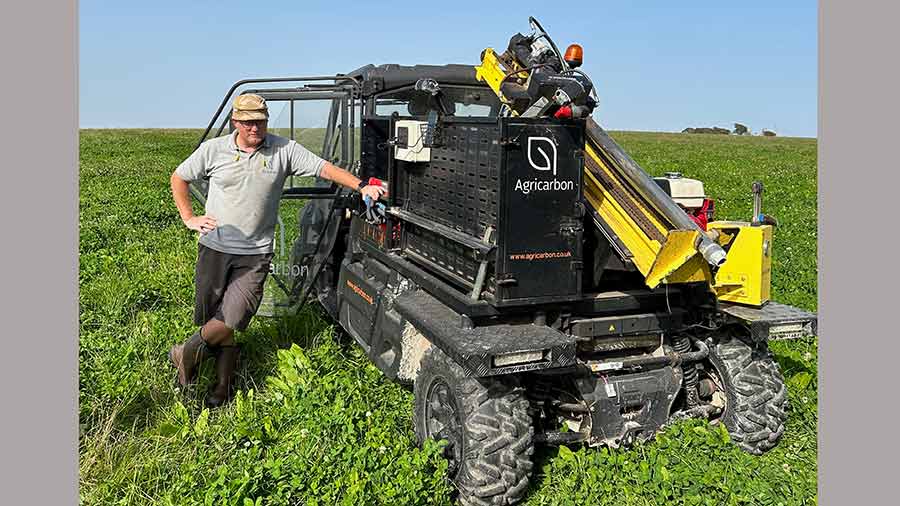Why cultivation equipment is making a comeback on Wiltshire farm
 © MAG/Mike Abram
© MAG/Mike Abram For the past eight years a direct drill was the only piece of equipment Wiltshire mixed arable and beef farmer George Hosier has used to establish his arable crops.
So it is with a bit of nervous laughter he says less than a minute into an introduction to the 600ha farm that a piece of cultivation equipment is arriving back on the farm in the next 24 hours.
See also: How Gabe Brown is building regenerative momentum across the world
“We’ve been doing things a bit differently for nine years now,” he explains. “We started direct drilling in 2014 and sold all our cultivation equipment in 2015.
“But there are two reasons we have a Vaderstad Carrier arriving tomorrow: one, to try to reduce our reliance on glyphosate, and two, to improve our spring cropping, particularly spring barley.”
Spring barley tends to follow winter wheat at Wexcombe Manor farm, which is in the North Wessex Downs area of outstanding natural beauty, potentially followed by spring oats.
The farm also grows oilseed rape, winter barley and about 80ha of herbal leys in the rotation, while the beef cattle enterprise is integrated into the arable rotation, grazing both herbal leys and cover crops.
“We’re finding crops are a little bit slow to get going in the spring behind cover crops, and where we’ve had more poaching from the cattle in the winter the crops have been better.
“Just like any form of tillage, the poaching is mineralising a bit of nutrition, which helps break down the lignin in the cover crop.”
That’s led him to the conclusion that a little bit of cultivation before spring crops may help improve their performance.
Glyphosate
The second factor is that the farm is also growing some wheat for Wildfarmed.
Under its rules, no pesticides, including glyphosate, are to be used during the three-year contract period, including before drilling.
Cultivation, therefore, will be needed to replace glyphosate to successfully establish a crop, George explains.
“But we’re certainly not moving wholeheartedly away from no-till, as the benefits it has brought us are huge.”
A trial run with a neighbour’s Vaderstad Carrier was used earlier this spring to lightly disc a failed oilseed rape crop to dissipate Astrokerb (propyzamide + aminopyralid) residues before a summer cover crop was planted costing £32/ha in seed.
By early September the cover crop, comprising species such as phacelia, buckwheat, sunflowers, radish and three types of clover, was nearly 2m tall and above-ground biomass cuttings suggested it contained more than 280kg N/ha, plus more phosphorus, potassium, sulphur and most trace elements than the following crop would need, George says.
“It’s not all going to be available for the following crop, but shows what a diverse crop will cycle.
“It’s also going to be drawing down carbon into the soil with the photosynthesis and building up populations of beneficial insects.
“We apply about 120kg N/ha on our wheats, but the last time we did this we put on 100kg N/ha and it was our best wheat by just over 0.5t/ha.”

Grazing
About 50-60% of the cover crop’s biomass will be removed through grazing by the farm’s beef herd (see “Daily mob grazing improves herd health”) during September, with the rest trampled, before being lightly cultivated and a Wildfarmed wheat and beans bicrop direct-drilled with a John Deere 750A in early October.
“We’d normally direct-drill into the cover. I don’t know what will happen when we run the Carrier through [with the residue], but we can’t spray it off.
“I’m going to have to make sure we graze enough off so the discs do a job, which is going to be one of the challenges.”
George is also growing summer cover crops to transition between herbal leys and wheat.
“We’ve found in a no-till system the wheat is very slow getting away after grass, which I assume is the allelopathic effect.
“We’ve had some success growing peas after grass, but less so since we introduced herbal leys.”
Unlike winter cover crops, currently there is no government support for summer cover crops, George notes.
“Both are important, but this is providing a lot of soil health benefits as well as wider biodiversity gains.
“If there was enough support, I would look at it being a greater part of our rotation to replace a break crop such as oilseed rape, linseed or peas,” he concludes.
Daily mob-grazing improves herd health

© MAG/Mike Abram
A 227-head always-outdoors beef herd is moved daily, 365 days a year, as one mob on Wexcombe Manor Farm.
The herd consists of 85 cows with calves, increasing to 112 next year, plus a growing suckler herd.
The cattle switch between permanent pasture, herbal leys and cover crops, with rest periods for grass ideally reaching 65-70 days, although that has been reduced to 55 days this year after George Hosier made more hay and silage, and slow growth on two new leys.
“It’s been a good year for shortening the rotation because we’ve had plenty of moisture to keep things growing,” he says.
The farm benefits from a water infrastructure legacy after George’s great-grandfather, who invented a mobile milking parlour in the 1920s, put in a water system across the farm for the dairy business.
While many of the concrete troughs have disappeared from that time, the standpipes remain in more than 50% of the fields, with George moving around four 600-litre water troughs on a John Deere Gator and connecting them to water using blue poly pipe.

© MAG/Mike Abram
He uses a single strand wire for fencing. “If we’re moving into a field of, say, 14ha that will do them for 10 days. We’ll set the whole paddock up in one day so you’re not putting fences up every day.
“Occasionally, and in winter time with cover crops, we have to ringfence the field so there is more work in winter, but there would also be if they were inside.
“On balance, moving every day is more work than our old system, but not hugely.”
The benefits are massive, he says. “Herd health has increased – we don’t usually see the vet.
“We do faecal egg counts and haven’t had the need to worm for seven years.
“We’ve not had a TB outbreak, whereas all our neighbours have been down at least once in the past five years.
“And the cattle are finishing as quickly as they used to when we fed them grains and brought them inside to finish, so in my view, it’s a system that works.”
Animals are slaughtered at 26-28 months at a target deadweight of 300kg, with about 50% of production sold through local butchers at a small premium.
Time right for soil carbon baselining
After 10 years of farming using conservation or regenerative practices, George Hosier believes the time is right to baseline his soil carbon stocks across the farm.
“In many ways, I should have done it 10 years ago, but we are where we are and if you don’t baseline, you’re missing out on a lot of regeneration and building of soil carbon,” he says.
“And if there is some way we can monetise it, I want to be in now rather than wishing I’d done it 15 years ago in five years’ time. It’s an evolving market and I think now is the right time.”
That’s led him to register for a programme run by Regenerate Outcomes, which combines soil carbon baselining and monitoring, provided by Agricarbon, with mentoring from US-based regenerative agriculture consultancy Understanding Ag, which was started by regen farmers Gabe Brown, Allen Williams and Shane New.
“We’re aiming to help UK farmers move to regenerative farming practices, be more sustainable, improve the quality of their soils and have all the benefits that follow on the back of those benefits,” explains Regenerate Outcomes director Chris Heathcote.
Understanding Ag mentors provide advice to help farmers manage soil, plants, animals and the farm business while increasing biodiversity and improving the ecological condition of the land.
The company has invested in the programme’s success by employing full-time UK adviser Kyle Richardville.
“We take the cost and risk out of farmers transitioning,” Chris claims.
“We pay for the ground to be baselined, we pay for eight hours of one-to-one mentoring, and for soil biology testing so the farming plan is as accurate as possible.
“We also provide support for kit such as water and fencing.”

Agricarbon representative with its soil sampling machine © MAG/Mike Abram
Five years
The increases in soil carbon stocks that should result from farming using regenerative practices will be measured by Agricarbon after five years and verified by Verra, which certifies carbon emission removals and reductions, issuing verified carbon units, a high-standard carbon credit.
These will provide an additional income stream for programme participants, Chris explains.
“We will help farmers either inset it into their supply chain, or sell those carbon credits to reputable buyers if that’s what they wish.”
For the first 10 years of the 30-year programme, Regenerate Outcomes recoups the upfront investment in the farm, including soil carbon testing, verification of carbon gains, and mentoring by taking approximately 30% of the carbon credits.
“Farmers are free to leave the programme at any time, as we recognise circumstances change and farmers need this level of flexibility,” Chris adds.
Verified carbon units for soil carbon sequestration are currently estimated to be worth £30-£50/t carbon dioxide equivalents, although Chris says the price for smaller amounts of credits could be significantly higher.
That kind of money is not to be sniffed at, George says. “Regenerate Outcomes talks about potentially being able to sequester up to 5t/ha of carbon, of which four would be [immediately] sellable [after a permanence buffer is allocated by Verra in case less carbon is sequestered than predicted by the Rothamsted RothC carbon modelling].
“It’s not replacing the Basic Payment Scheme, but if we can get something to help fill that gap, it’s got to be worth it.”
With 50% of the arable area growing cover crops annually, just under 25% of the farm in various forms of grass, rotational grazing, direct drilling and reductions in inputs, leading to improved soil health, he believes increases in soil carbon should be occurring.